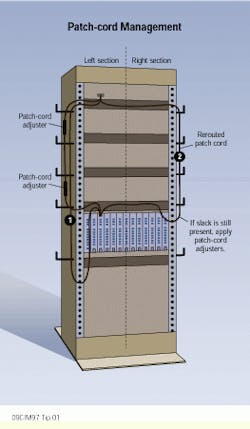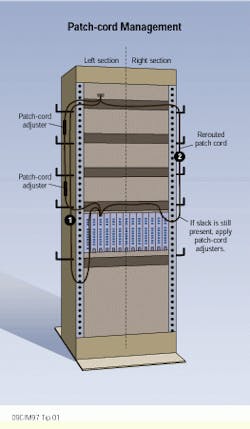How to route patch cords
Dennis Mazaris
PerfectSite
Problem
When someone installs a patch cord in a management system, typically little, if any, attention is paid to patch-cord routing. After all, patching is by its nature a task to be performed quickly. This causes disorganization of the patch-cord management system and decreases the performance of the network by increasing the time needed to identify and rectify faults.
Solution
Establish a simple guideline that will provide the support needed to understand and teach someone how to route patch cords in the most efficient manner possible.
Procedure
1) Divide the equipment rack into two equal vertical sections (i.e., left and right).
2) Route patch cords through horizontal and vertical managers. When routing a patch cord, you must always route it in a path that will eliminate all of the patch-cord slack. If slack is present after your first attempt at routing, you may reroute or apply patch-cord adjusters to eliminate the slack.
3) Routing and patching should be performed in one section at a time. Crossing a section should occur only when you need to eliminate patch-cord slack.
4) If patch-cord slack is present after rerouting, apply adjusters. If the adjuster can be applied as shown in the illustration or within a single section, then route the patch cord appropriately to accomplish this task. Try to avoid crossing a section.
The key to patch-cord routing is to have an adequate number of horizontal and vertical managers in your system and to eliminate slack in each patch cord by using your managers and patch-cord adjusters.
In the illustration, #1 shows that there is patch-cord slack in the equipment rack. This patch cord should have patch-cord adjusters applied to eliminate slack or, as shown by #2, the patch cord must be rerouted through horizontal and vertical managers to eliminate slack. Note: Trying to reroute slack through managers as in #2 may still result in patch-cord slack. When this occurs, apply patch-cord adjusters to eliminate slack.
Dennis Mazaris, registered communications distribution designer (rcdd), is the principal consultant for PerfectSite (Sterling, VA), a consulting firm specializing in premises cabling management and design.

